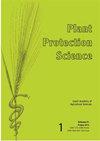Evaluation of Incidence, Some Wheat Lines and Fungicides for their Performance against Leaf Rust of Wheat in Sindh Province of Pakistan
IF 1.7
4区 农林科学
Q2 AGRONOMY
引用次数: 0
Abstract
Rusts cause considerable qualitative and quantitative losses to the wheat crop. However, their severity and losses can be minimized through the deployment of resistant cultivars. Current investigations were made to conduct surveys for leaf rust in Sindh province to scrutinize wheat germplasm against the disease and to check the efficacy of potential fungicides in controlling leaf rust of wheat. Experiments were conducted under artificial conditions at Nuclear Institute for Agriculture, Tandojam. Cobb's scale was used for disease ratings. Among screened wheat lines, one was rated as resistant, two were found moderately resistant, six showed moderately resistant and moderately susceptible type reactions, and one line exhibited moderately susceptible reaction. Moreover, the correlation between severity ratings (area under disease progress curve (AUDPC) and yield traits unveiled that there was a negative correlation between AUDPC and spike length, awn length, plants/sq.ft., and grain yield while a positive correlation for remaining traits. Among fungicides, Tilt and Bloom were found to be the most effective in controlling leaf rust. It is, therefore, recommended that the resistant genotypes should be used in future breeding programs to evolve resistant materials against leaf rusts of wheat and the most effective fungicides be used for the management of the disease to minimize yield losses.巴基斯坦信德省小麦叶锈病发病率、部分小麦品系及杀菌剂防治效果评价
锈病对小麦作物造成相当大的质量和数量损失。但是,通过使用抗病品种,可以将其严重程度和损失降到最低。目前的调查是在信德省进行叶锈病的调查,以审查小麦种质的抗病性,并检查潜在的杀菌剂对小麦叶锈病的防治效果。实验在坦多贾姆核农业研究所的人工条件下进行。科布量表用于疾病分级。在筛选的小麦品系中,1个品系为抗性品系,2个品系为中等抗性品系,6个品系表现为中等抗性和中等敏感型反应,1个品系表现为中等敏感型反应。此外,疾病进展曲线下面积(AUDPC)与产量性状的相关性表明,AUDPC与穗长、芒长、株数/平方英尺呈负相关。,其余性状与产量呈正相关。在杀菌剂中,对叶锈病防治效果最好的是Tilt和Bloom。因此,建议在未来的育种计划中使用抗性基因型,以进化出抗小麦叶锈病的材料,并使用最有效的杀菌剂进行病害管理,以尽量减少产量损失。
本文章由计算机程序翻译,如有差异,请以英文原文为准。
求助全文
约1分钟内获得全文
求助全文
来源期刊

Plant protection science
Agronomy-PLANT SCIENCES
CiteScore
2.90
自引率
7.70%
发文量
30
审稿时长
12 weeks
期刊介绍:
Original papers, short communications, critical reviews, personal news, and book reviews covering all areas of diseases and pests of plants, weeds and plant protection. Papers are published in English.
 求助内容:
求助内容: 应助结果提醒方式:
应助结果提醒方式:


